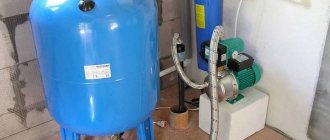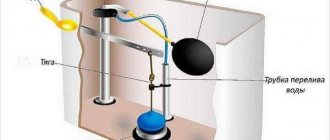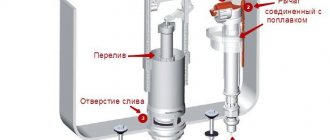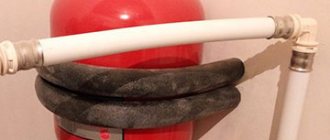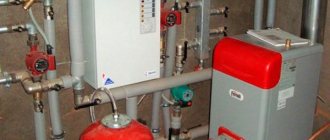Over the weekend I redid the heating and moved the expansion tank into the attic. The old one was made from a plastic canister into which a special brass adapter was screwed so that a pipe could be connected, I don’t know what it’s called correctly, in order to screw the brass adapter into the canister I had to cut a hole like this (see photo below), at first the heating was imperfect and somewhat since my system boiled, so the canister from under the primer began to leak a little, this is clearly noticeable, but nevertheless, for two winters the canister faithfully served as an expansion tank.
This canister was hanging in an unfinished room and confused me, I had long wanted to take it out into the attic, and suddenly I came up with a way to make a hole in the canister and attach a brass fitting without cutting a huge hole for a hand to insert it from the inside. We take a canister from under the primer, I took 10 liters, this is enough for my heating with a reserve:
We make a hole in the right place, I made it just above the bottom, so that if suddenly some debris gets in, it won’t get into the heating system and will simply settle to the bottom. The hole is easily made using a utility knife; I periodically check whether the fitting fits in and cut off the excess.
Now there are two holes in the canister, one standard and the second made by me, we insert a piece of wire into both, and the fitting slides along it directly to the hole made
I push the fitting into the hole, put on the rubber gasket
I put on the nut and tighten it, the expansion tank is ready
My heating tank is connected by a piece of rubber hose with clamps, but you can solder an American pipe to a plastic pipe and connect it more thoroughly, but as my two years of experience have shown, it’s quite reliable.
After moving the tank into the attic it looked like this:
Heating equipment
The expansion tank compensates for the increase in the volume of heated coolant, reducing the pressure in the wiring. Therefore, such a unit must be present in both open and closed heating systems. Moreover, you can even make a tank for a closed system with your own hands, using homemade or ready-made containers.
Purpose of the expansion tank for the heating system
The coolant (this is water) circulates throughout the system continuously and this movement occurs because there is pressure inside. It is created under gravity or forcibly if an electric pump is connected. In any case, the heating system cannot be considered complete if there is no expansion tank.
It can be of 2 types:
- Open.
- Closed or sealed.
An expansion tank is simply necessary in a water heating system, because when heated, the liquid tends to increase in volume. There is more water and the pressure in the system increases. Sometimes the pressure can be so strong that the system cannot withstand the load. But nothing can be done with water, because it cannot be compressed. If you install a heating system without an expansion tank, the water can rupture the pipes. To prevent this from happening and to ensure that the pressure in the system remains stable, it is necessary to install a container so that this reservoir compensates for pressure drops when heating the water. This is the expansion tank. It turns out that without this reservoir the heating system cannot operate fully.
An expansion tank can be purchased at a specialized store or made independently.
Heating system installation
Figure 3. Do-it-yourself heating of a private house.
It is advisable to begin the installation of a heating system by drawing up a diagram, which should indicate the detailed layout of pipes and radiators, and all the necessary calculations regarding the amount of materials. An example of such a scheme is in Figure 1. Radiators are usually placed under the windows.
Try to position the pipes in such a way as to avoid unnecessary bends and turns, leading to a decrease in the efficiency of the heating system. It is necessary to mark on the diagram the highest point of the system. An expansion tank for heating is installed in this place.
Laying pipes is not particularly difficult. The pipe from the boiler is led to the radiator. The radiator itself is installed and connected. Then comes the laying of the pipe to the next battery. The procedure is repeated several times. It is advisable to equip each radiator with a tap, with the help of which it will be possible to get rid of possible air pockets during operation of the heating system.
Layout of heating elements for a warm water floor.
The circuit is closed in the same boiler where the wiring began. It is recommended to equip the boiler with a filter for water purification, and sometimes with a pump for water circulation. It is necessary to provide for the installation of drainage and water filling systems in the heating system. It is advisable to carry out the initial launch of the system in the presence of a competent specialist.
Instead of installing traditional radiators, you can equip a warm heated floor by laying metal-plastic or polypropylene pipes under the floor covering. Hot water will circulate through the pipes and transfer its heat to the room. Heated floor diagram in Figure 2.
In general, it is advisable to carry out heating installations with the assistance of someone experienced in these matters, so as not to encounter unnecessary problems during operation. Water heating is about 20 percent cheaper than stove heating. The return line is laid close to the floor, sometimes under it. Hot water supply pipes are located above the radiators, usually near the ceiling. It is advisable to insulate sections of pipes located under the floor or in the attic to prevent them from freezing in winter.
Pipes can be used steel or metal-plastic. For risers, a diameter of ¾ or 1 inch is suitable. Half-inch pipes are suitable for wiring. Horizontal pipes are laid with a slope of 0.1 degrees in the direction of the movement of hot water.
Main functions of the expansion tank
The first and main thing that the expansion tank must cope with is:
- Stabilize instrument readings (pressure gauge) by compensating for the expansion of liquid in the system.
- Remove air from the system.
- Accumulate hot liquid.
Before you start making an expansion tank, you need to find out how it copes with increased loads. When the liquid in the system heats up, it increases more than we would like. The excess of this liquid must flow into a separate tank, then the operation of the heating system will be stable. It is into this reservoir that the excess heated liquid enters. When the water cools down, it flows back into the heating system. If the tank is sealed, then the membrane handles this part of the work, and in an open system, by gravity the water cools and returns back to the circuit.
Thanks to the expansion tank, the water in the system always remains in the same amount, as well as the pressure. This is the main task that the expansion tank copes with. There are also auxiliary functions that this tank can also handle - removing air pockets. Therefore, it is best to install the tanks at a high point in the system with a slight slope so that the water helps push the air upward.
Features of the internal structure
The basis of the toilet flush tank includes 2 systems - an automatic water supply system and a water drainage mechanism. If you know the operating principle of both systems, it is easy to troubleshoot problems that arise. To make it easier to understand the mechanism of operation of the flush tank, you should first familiarize yourself with the diagram of old toilet tanks, since their systems are more understandable and simpler than modern mechanisms.
Tanks of older designs consist of elements for supplying water to the tank, as well as a drainage device. The water supply mechanism includes an inlet valve with a float, and the drain system includes a lever and bulbs, as well as a drain valve. There is also a special tube, the function of which is to remove excess water in the tank without using the drain hole.
The normal operation of the entire structure depends on the reliable operation of the water supply elements. In the image below you can see the automatic water supply circuit in more detail. The inlet valve is connected to the float using a shaped lever. One end of this lever is connected to a piston that either shuts off the water or opens the water.
How to make an expansion tank for heating with your own hands
It is very difficult to make a sealed tank at home. As experts say, it is better to pay and buy a quality item than to make it yourself.
But if you have a great desire, then you can make an expansion tank for the heating system with your own hands:
- First you need to make a body or frame. It must be made of 2 metal parts;
- a flange must be attached to each part to screw the membranes and connect both halves;
- there will be 2 chambers inside - air will enter into one, liquid will accumulate in the other. Both halves should not be interconnected, otherwise nothing will work;
- you need to insert a pipe into one of the parts to allow excess liquid to flow in, and insert a nipple into the second part to regulate the amount of free air in the system (to bleed air);
- the body should be metal, but the membrane should be rubber. It must be installed between the two halves of the chamber, and the flange must be bolted together. We remind you once again that absolute tightness must be observed;
- All that remains is to install the tank in place, turn it on to the heating system and check the operation;
- and another very important thing is that the pressure in the tank must be adjusted individually, according to the parameters of the boiler.
Water heating options
Figure 2. Diagram of a water heated floor.
Most often, the house is equipped with water heating. The options are as follows: connect to the water supply and sewerage system, if possible, and create autonomous heating. To connect to the centralized system, you need to complete some documents and obtain the appropriate permissions. Autonomous heating systems have a number of completely solvable problems that require financial investments, a little calculation and a lot of work.
Water heating equipment requires some preliminary work. More often, a system of natural circulation of coolant is used, which is usually ordinary water. No additional pumps are required here. Cooled water flows from the batteries into the boiler and displaces hot water, which enters the heating radiators. This circulation occurs continuously. To do this, the temperature difference between hot and cooled water should be approximately 25 degrees.
This result can be achieved by placing a heating boiler in the basement of the house. If this is not possible, then the boiler is placed in the basement no higher than the radiators. This system is called two-pipe, since hot and cooled water are supplied through different pipes.
Making an open expansion tank for heating with your own hands
You can make an open type expansion tank with your own hands. Not so long ago, when not many people knew about installing individual heating, there was no talk about an expansion tank - it was attached at the last moment from what came to hand. A large diameter flower pot or any suitable container was used as a tank. Today, an expansion tank can be purchased in a store or you can make an open-type expansion tank with your own hands. This is much easier than making a closed tank.
- marker;
- ruler;
- Metal sheet;
- Bulgarian;
- basalt wool;
- welding machine;
- gloves and other protective equipment.
How to make a tank:
It is better to make the tank from stainless steel, then the tank will last for many years. If there is no such material, then use any metal.
- We make the markings: the dimensions of the tank depend on the length of the heating system circuit. If this is a standard, then you need to cut 5 squares measuring 30 by 30 or 30 by 40 cm. These are the walls for the tank and the bottom.
- The workpieces must be assembled, placed at right angles and welded with a welding machine.
- The design is ready, you need to drill a hole in the bottom of the tank to insert the pipe. Through it, water from the system should flow into the tank. The pipe must be connected to the heating system (looped).
- It is advisable to insulate the expansion tank, because often the highest point of the circuit is in an unheated room in the house (the attic). Therefore, it is necessary that the expansion tank be insulated so that the water in it does not freeze. You can use any insulation, for example, basalt wool. It is resistant even to the highest temperatures.
- You need to be prepared for the fact that in an open tank (open circuit) the water reaches the boiling stage. Therefore, when choosing insulation, take these nuances into account.
DIY expansion tank for heating. Photo
Manufacturing and installation
To make an expansion tank for a heating system yourself, you need to have sheet metal, pieces of pipes of different diameters and a couple of corners in case you need to strengthen the wall or secure the container in place. Tools and equipment you will need:
- welding machine;
- angle grinder;
- drill;
- a set of metalwork tools;
- tape measure, square.
Note. You can often hear advice that it is better to weld the container from stainless steel. This is good advice; it is relevant when the system is installed from polymer or stainless steel pipes. If everything is made of metal, then there is nothing to worry about; you can cook it from simple “black” steel.
Any home craftsman with welding skills knows how to weld a box. Then the pipes are cut into the open expansion tank and sealed hermetically. The lid is made loose so that air can pass inside freely. When everything is ready, all that remains is to check the welding seams for permeability and install the container in place, as shown in the diagram:
To avoid unnecessary heating of the attic space, after installation the tank body must be well insulated; mats or slabs made of mineral wool are suitable for this purpose. Or you can cover the body with sheets of foam plastic. Some other craftsmen automate tank refilling using a “toilet” float kit, but this is not a very reliable option. Remember how often the toilet gurgles in your home and you will understand what we are talking about.
DIY expansion tank from a canister
Metal makes a reliable and durable structure, but not everyone knows how to work with this material, so we suggest you read the step-by-step instructions and learn how to make a tank from a canister:
- We immediately draw the reader’s attention to the fact that a plastic canister will not last long, a maximum of 2 winters. Therefore, although this option is fast, it is not durable. In any case, the time will come when you have to replace the old tank with a new one.
- You will need a canister with a volume of 10 liters; there is no need to cut a huge hole, but in the lower part, closer to the bottom to the right, we cut out a neat hole. This can be done easily with an ordinary construction knife. Check whether the fitting fits well into the finished hole; if not, then you need to cut off a little more excess plastic.
- The canister has 2 holes - the first is factory-made, the second we made at the bottom. You need to insert a wire and a fitting into both holes so that it slides along the wire directly into the lower hole.
- You need to insert the fitting and install the rubberized gasket, then the nut and tighten the thread thoroughly.
- You can connect such an expansion tank to the heating system using a piece of rubber hose (install clamps) or take a piece of plastic pipe and make the structure solid.
DIY expansion tank. Photo:
Tank made of stainless steel or plastic container
An expansion tank can be easily built with your own hands. To do this, simply make a container that has the required volume. Often the tank is made of stainless steel sheet 2-4 mm thick. You can also use ready-made plastic containers. Before starting work, you need to prepare the necessary tools and materials.
Sheet layout
At the initial stage, the prepared sheet of metal is marked. First, a diagram of the future tank is drawn on paper. This will minimize waste. When cutting, it is worth considering that the grinder disc will take up several millimeters. After cutting, carefully clean all edges.
Cutting blanks
A grinder is used to cut metal. At this stage, you will need to prepare five or six blanks. The exact number of parts depends on the availability of the cover. If the tank is large, the lid can be divided in two. One part is tightly attached to the body, and the second is installed on the curtains.
Welding work
During connection, the workpieces are installed at right angles. In this case, welding can be carried out using different technologies. It all depends on the thickness of the metal. For workpieces made of 2 mm steel, gas welding is used. But, the connection of steel 4 mm thick is carried out using electric welding.
A hole is made in the bottom of the body (bottom), to which a pipe of the required diameter is welded. A pipe for supplying coolant will be connected to it in the future. The pipe is also connected to the general communication circuit.
Welding is carried out in different ways
Thermal insulation
As already noted, the tank is installed on top of the system. It is often installed in the attic. The peculiarity of such a room is that it is not heated. Therefore, the temperature in it is low, and sometimes even negative. This increases the risk of the water in the tank freezing. As a result, the system will not work and may be damaged.
To eliminate the occurrence of such a problem, experts recommend carrying out thermal insulation work in advance. To insulate the system, it is recommended to use special materials, such as basalt wool. It resists well the high temperature that is created when the container is heated.
Adding oil
In addition to the main one, other holes with pipes are made in the tank body, which perform certain functions. So, it is necessary to install an additional element through which coolant will be added to the tank. Another hole serves as an emergency drain for excess water or oil. The second end of the pipe is connected to a sewer or a separate tank.
Since the tank is not sealed, water will evaporate during the heating of the house. In addition, air may enter the system through the cap. This is fraught with overheating of the pipes and disruption of the normal circulation of the coolant. To prevent this, experts recommend adding a little oil to the tank. It will cover the surface of the water with a thin film, which will protect the system from air.
Volume calculation
When calculating the volume of the unit, it is worth considering many factors. The size of the tank is 5% of the amount of coolant in the system. In this case, add 2% for evaporation and 1% for reserve, which will prevent water from overflowing over the edges. If the system uses a different coolant, the value will be slightly different. It all depends on the coefficient of thermal expansion.
To determine the volume of the system, you need to sum up the volume of the pipes, battery and the boiler itself. You can also use a more simplified scheme. According to it, a boiler with a power of 1 kW is installed in systems with a volume of 15 liters.
Purpose and types
In a heating system, the temperature of the coolant constantly changes, which leads to changes in its volume. It is known that liquids expand when heated and contract when cooled. The expansion tank for heating is precisely designed to absorb excess liquid during heating (expansion) and return it to the system when cooling. Thus, it maintains stable pressure in the heating system.
Heating expansion tank painted red
Open type
There are two types of expansion tanks: open and closed. Open type containers are usually used in gravity systems (with natural circulation). It is called this because it is a non-sealed container. This could be a barrel, a pan, or a specially welded tank. In order for the coolant to evaporate less, a lid is installed, but the container itself is not airtight. The principle of operation of an open expansion tank is simple: it is a container into which excess coolant is forced out when the temperature rises and is supplied back when it cools.
Open type expansion tank - any container, for example, a plastic canister
When calculating open-type tanks, take a significant reserve in volume: you can add coolant and not check its level for some time. The container is not airtight, so there is constant evaporation of liquid and a supply will not hurt. If there is a lack of coolant, air will enter the system, which can stop it. The consequences can be sad - if the boiler’s automatic system works (if it has one), there is a possibility of defrosting. If there is no automation, the boiler may rupture due to overheating. In general, this is the case when the stock is really justified.
If the heating system is filled with water, you can make an automatic replenishment based on a float from the toilet cistern. The principle of operation is exactly the same: when the level drops below a certain point, the water supply opens. When the required level is reached, the supply is shut off.
Expansion tank for open type heating with float
The advantage of this solution is that there is no need to control the amount of coolant, the possibility of airing is minimal. The downside is that you have to pull the water pipe. Since open systems usually operate on natural circulation, the expansion tank for heating is placed at the highest point of the system. Very often this is an attic, so the route turns out to be long.
And these are not all possible emergency situations. Floats sometimes do not shut off the water supply. If this happens to the toilet, the water simply runs into the drain. In the case of heating, water will flow into the attic, flooding the house... To avoid such a situation, it is necessary to control the overflow. In the simplest case, it is a pipe welded/attached at the required level with a hose connected to it. The hose can be led into the sewer, but then you also need to come up with an overflow alarm (at the same time, the level will drop below critical). You can simply lead the hose a meter away from the house or run it into the drainage system. In this case, “traces” of overflow will be visible and it will be possible to respond in a timely manner without an alarm. So an open expansion tank for heating requires some retrofitting.
Container design
The shape of the tank can be round or rectangular, it doesn’t really matter. It's just that a rectangular tank is a little easier to make. At the same time, with large volumes of liquid, a square tank will require reinforcement of the walls, which makes the entire structure heavier. But it needs to be lifted into the attic. A round vessel can be made from a pipe, but it is more difficult to attach a lid to it, and its capacity will be less. The choice is yours.
Note. Often, homeowners, in order to avoid fiddling around for a long time, make an open-type expansion tank from all sorts of plastic containers - buckets, cut canisters, and so on. But we need a good-quality metal tank, so we won’t talk about canisters.
In general, the tank is a metal container with an open top, closed with a lid. There are pipes cut into the body of the product for connecting the heating system and the overflow hose. There is also a more advanced design, where there are 4 pipes, the functions of each of them are indicated in the diagram:
There is a supply and return branch, connected to the return line, so that the water does not stagnate, as well as a minimum level control pipe. The latter function is very convenient to use; there is no need to climb into the attic to make sure there is water. True, with this option the installation becomes more complicated; you will have to lay additional pipes through the ceilings yourself.
Many homeowners make do with two pipes - for coolant and overflow. When adding water to the system, open the tap and monitor the hose leading outside. The make-up tap is closed when water runs out of the hose, but then the tank is full to the brim and when heated, coolant flows out of it through the overflow for a long time.
There is another design for a homemade container, although it can hardly be called open. The interior of the tank does not communicate with the atmosphere and is only half filled with water. The remaining part is occupied by air, which plays the role of a damper during the expansion of the coolant. This heating system tank has a pipe for replenishing water, draining and connecting to the piping network. The design is shown in the figure:
Determining the volume of the expansion tank and its selection
For normal heating operation, the expansion tank must have sufficient volume. There are two ways to determine it: you can calculate it using a formula, or you can use empirical data.
The volume of the expansion tank for heating is selected for each system
Empirical path
Let's start with the empirical method. Based on operating experience, it was concluded that if the volume of the expansion tank for heating is about 10% of the total volume of the heating system, this is sufficient. The question is how to determine the volume of the system. There are at least two ways:
- Count when filling (if it is filled with water and there is a meter, or when filling with coolant from canisters, you will know exactly how much liquid was pumped in).
- Calculate by volume of system elements. You will need to find information about how many liters fit in one meter of pipe, in one section of the radiator. With this data you can already find out the volume of the heating system.
Coolant volume in pipes of different diameters
Knowing how many liters of coolant are in your heating, it is easy to calculate the required volume of the membrane tank - it should be at least 10% of this figure. In the case of an open type tank, the actual volume can be at least doubled - there is less chance that the tank will be empty. At a minimum, you should add half - you will still underfill it by at least 1/3.
A membrane expansion tank for heating is usually taken without overestimating the calculated figure. The fact is that the larger the capacity, the more expensive the expander costs. And the price increase is significant. However, you should not take a smaller one - the pressure will “jump”, which will lead to early wear of components or even shutdown of the system. It is most likely that the heating will fail in cold weather, because in cold weather the coolant is hotter, which means its volume is larger. And it is at these moments that the volume of the expansion tank may not be enough. If you notice such symptoms and the calculation confirms that your membrane tank is of insufficient size, it is not necessary to change it to a larger one. You can put a second one. It is important that their total capacity is not less than the calculated value.
If there is antifreeze in the system
Heating antifreeze has greater thermal expansion than water. Moreover, different brands have different characteristics. Therefore, for this type of coolant, it is advisable to pre-calculate the volume of the expansion tank.
There are two ways: determine how for water, make an adjustment for greater thermal expansion. It depends on the percentage of ethylene glycol (antifreeze). For every 10% glycol, add 10% volume. That is:
- 10% ethylene glycol - must add 10% of the found volume of the water tank;
- 20% ethylene glycol - add 20%, etc.
This calculation is usually justified, but more accurate figures can be found using the formula (shown in the figure).
Formula for calculating the volume of an expansion tank for a heating system
Once you have decided on the volume, it's time to buy an expansion tank. But in the store they are in different colors. At a minimum, there are blue (cyan) and red. So, the membrane expansion tank for heating is always red . Blue ones are for plumbing, and for cold water. They are much cheaper, but the membrane there is made of rubber not suitable for high temperatures. So it will not last long in the heating system.
How to make a calculation?
As mentioned above, any expansion tank used for open heating is characterized by simplicity of design and manufacture. And calculating the dimensions of such a product is no more complicated.
For this purpose, you can use formulas or a method that involves approximate calculation of the working volume of the tank.
In reality, to determine the required capacity of the tank, the owners of a small country house use formulas extremely rarely. Most often, the approximate volume of the expansion tank is calculated, to which any number of liters can be added for insurance.
Reason: in the case of open tanks, the extra volume does not significantly affect the cost, and in some cases does not lead to an increase in price at all.
As a result, the entire calculation of capacity comes down to determining 10% of the volume of the entire coolant, which should be its minimum value for the expansion tank.
The easiest way to do this is at the time of designing and creating a heating system, when all the parameters of radiators, pipes and other structural elements are known or can be easily found out by taking measurements. And then simply adding up the volumes of all components.
If the source data is unknown, then the most practical method of calculation is experimental. Why do you need to drain all the water from the system and then refill it with coolant?
In this case, measurements must be made, which can be done using a meter or using containers of known volume. After that, all that remains is to find out the required 10% of the coolant volume, which serves as a guideline when making or purchasing a tank.
Pressure in the membrane tank and checking it
For a closed heating system to work properly, the pressure in the expansion tank must be 0.2-0.5 Bar lower than in the system. The larger the system, the greater the pressure difference. But, as already said, at the factory they are pumped up to 1.5 Bar, so before installing the expander, it is better to check it and adjust it to your heating system.
The spool is often hidden under a plastic cover
We check the pressure with a pressure gauge by connecting it to the outlet with the spool. If the pressure is higher than you need, bleed off a little. This is not difficult to do - press the petal in the nipple with something thin. You will hear the hiss of escaping air. When the pressure reaches the desired level, release the petal.
If the membrane tank is inflated too weakly (this also happens), it can be inflated with a conventional pump. But it’s more convenient to use a car one, with a pressure gauge - you can immediately control the pressure. After verification, you can install it on the system.


